Corporate Accounting and Reporting: Finance Lease and Impairment
VerifiedAdded on 2023/04/24
|8
|1518
|240
Report
AI Summary
This report delves into the specifics of corporate accounting and financial reporting, focusing on the critical aspects of finance lease disclosures as outlined in AASB 16. It examines how lessors and lessees should present relevant information to accurately reflect lease-related transactions, impacting c...
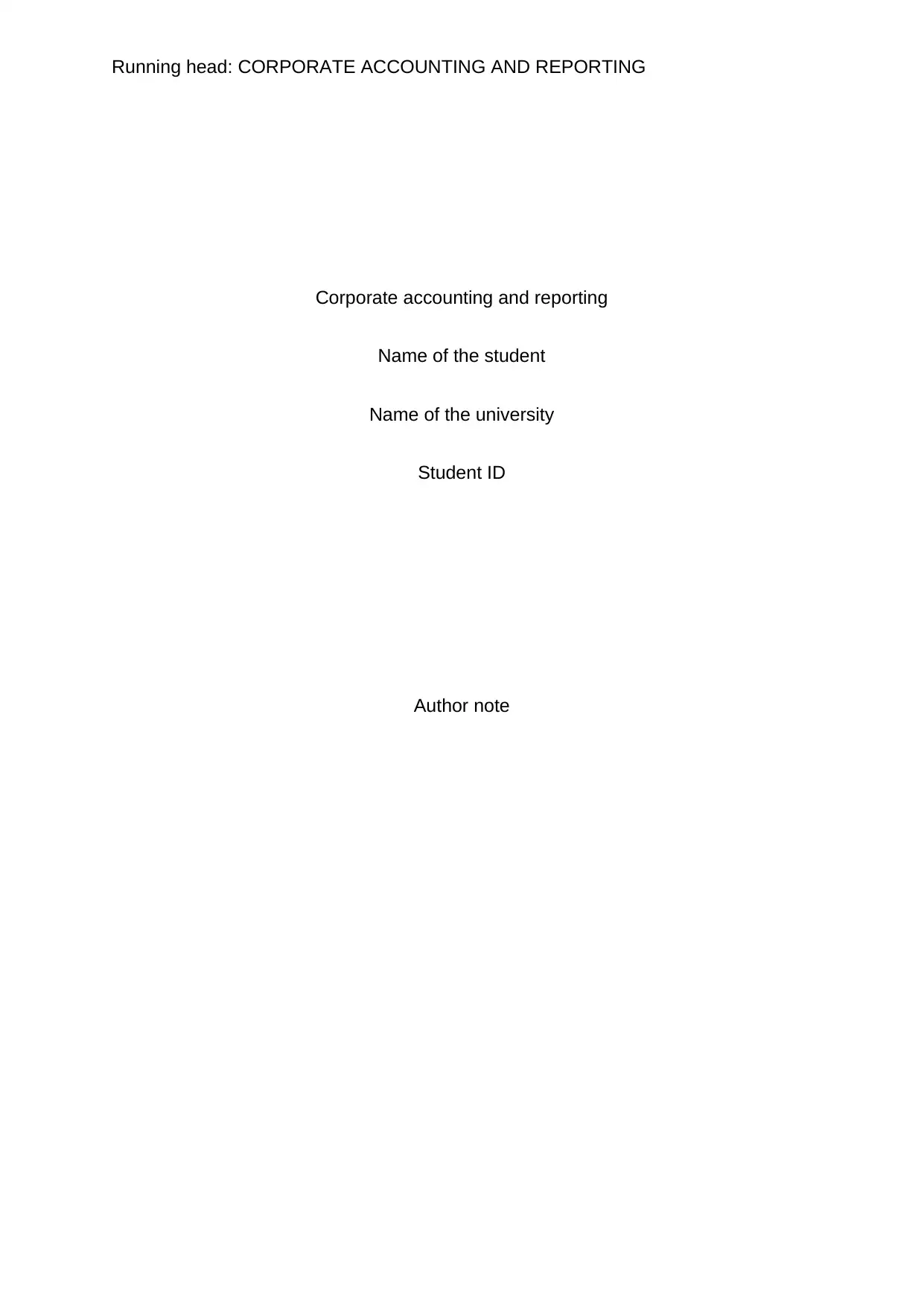
Running head: CORPORATE ACCOUNTING AND REPORTING
Corporate accounting and reporting
Name of the student
Name of the university
Student ID
Author note
Corporate accounting and reporting
Name of the student
Name of the university
Student ID
Author note
Paraphrase This Document
Need a fresh take? Get an instant paraphrase of this document with our AI Paraphraser
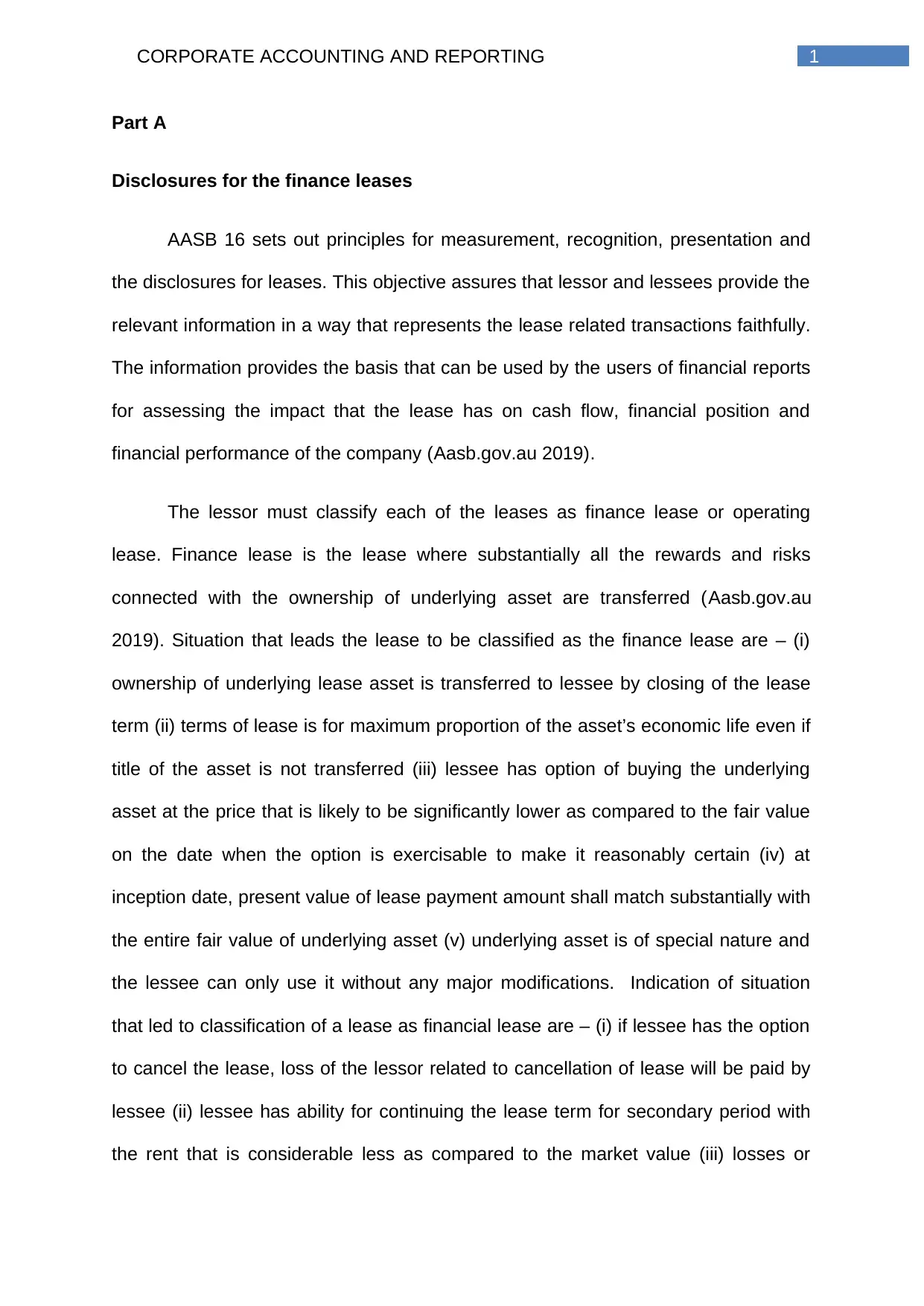
1CORPORATE ACCOUNTING AND REPORTING
Part A
Disclosures for the finance leases
AASB 16 sets out principles for measurement, recognition, presentation and
the disclosures for leases. This objective assures that lessor and lessees provide the
relevant information in a way that represents the lease related transactions faithfully.
The information provides the basis that can be used by the users of financial reports
for assessing the impact that the lease has on cash flow, financial position and
financial performance of the company (Aasb.gov.au 2019).
The lessor must classify each of the leases as finance lease or operating
lease. Finance lease is the lease where substantially all the rewards and risks
connected with the ownership of underlying asset are transferred (Aasb.gov.au
2019). Situation that leads the lease to be classified as the finance lease are – (i)
ownership of underlying lease asset is transferred to lessee by closing of the lease
term (ii) terms of lease is for maximum proportion of the asset’s economic life even if
title of the asset is not transferred (iii) lessee has option of buying the underlying
asset at the price that is likely to be significantly lower as compared to the fair value
on the date when the option is exercisable to make it reasonably certain (iv) at
inception date, present value of lease payment amount shall match substantially with
the entire fair value of underlying asset (v) underlying asset is of special nature and
the lessee can only use it without any major modifications. Indication of situation
that led to classification of a lease as financial lease are – (i) if lessee has the option
to cancel the lease, loss of the lessor related to cancellation of lease will be paid by
lessee (ii) lessee has ability for continuing the lease term for secondary period with
the rent that is considerable less as compared to the market value (iii) losses or
Part A
Disclosures for the finance leases
AASB 16 sets out principles for measurement, recognition, presentation and
the disclosures for leases. This objective assures that lessor and lessees provide the
relevant information in a way that represents the lease related transactions faithfully.
The information provides the basis that can be used by the users of financial reports
for assessing the impact that the lease has on cash flow, financial position and
financial performance of the company (Aasb.gov.au 2019).
The lessor must classify each of the leases as finance lease or operating
lease. Finance lease is the lease where substantially all the rewards and risks
connected with the ownership of underlying asset are transferred (Aasb.gov.au
2019). Situation that leads the lease to be classified as the finance lease are – (i)
ownership of underlying lease asset is transferred to lessee by closing of the lease
term (ii) terms of lease is for maximum proportion of the asset’s economic life even if
title of the asset is not transferred (iii) lessee has option of buying the underlying
asset at the price that is likely to be significantly lower as compared to the fair value
on the date when the option is exercisable to make it reasonably certain (iv) at
inception date, present value of lease payment amount shall match substantially with
the entire fair value of underlying asset (v) underlying asset is of special nature and
the lessee can only use it without any major modifications. Indication of situation
that led to classification of a lease as financial lease are – (i) if lessee has the option
to cancel the lease, loss of the lessor related to cancellation of lease will be paid by
lessee (ii) lessee has ability for continuing the lease term for secondary period with
the rent that is considerable less as compared to the market value (iii) losses or
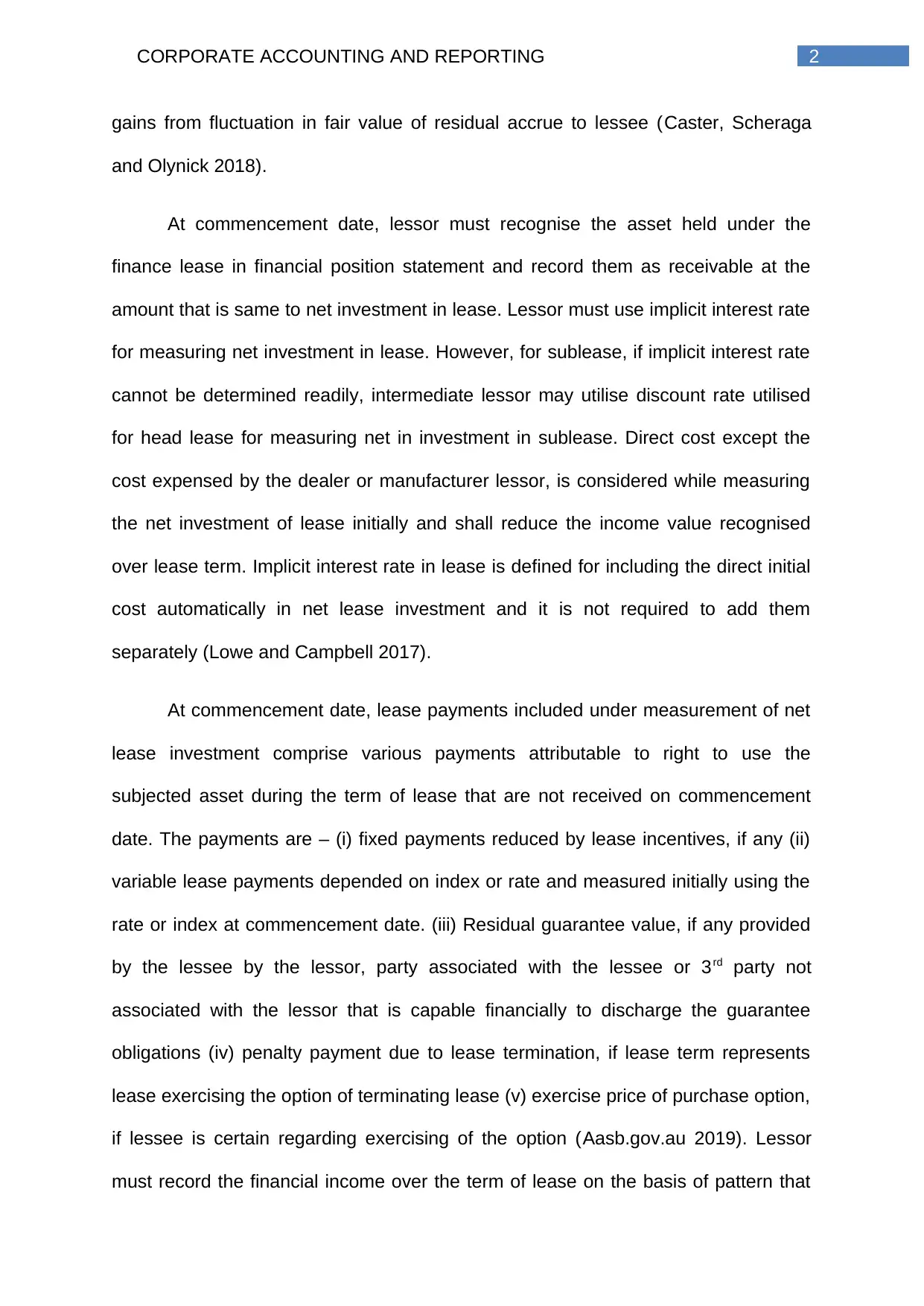
2CORPORATE ACCOUNTING AND REPORTING
gains from fluctuation in fair value of residual accrue to lessee (Caster, Scheraga
and Olynick 2018).
At commencement date, lessor must recognise the asset held under the
finance lease in financial position statement and record them as receivable at the
amount that is same to net investment in lease. Lessor must use implicit interest rate
for measuring net investment in lease. However, for sublease, if implicit interest rate
cannot be determined readily, intermediate lessor may utilise discount rate utilised
for head lease for measuring net in investment in sublease. Direct cost except the
cost expensed by the dealer or manufacturer lessor, is considered while measuring
the net investment of lease initially and shall reduce the income value recognised
over lease term. Implicit interest rate in lease is defined for including the direct initial
cost automatically in net lease investment and it is not required to add them
separately (Lowe and Campbell 2017).
At commencement date, lease payments included under measurement of net
lease investment comprise various payments attributable to right to use the
subjected asset during the term of lease that are not received on commencement
date. The payments are – (i) fixed payments reduced by lease incentives, if any (ii)
variable lease payments depended on index or rate and measured initially using the
rate or index at commencement date. (iii) Residual guarantee value, if any provided
by the lessee by the lessor, party associated with the lessee or 3rd party not
associated with the lessor that is capable financially to discharge the guarantee
obligations (iv) penalty payment due to lease termination, if lease term represents
lease exercising the option of terminating lease (v) exercise price of purchase option,
if lessee is certain regarding exercising of the option (Aasb.gov.au 2019). Lessor
must record the financial income over the term of lease on the basis of pattern that
gains from fluctuation in fair value of residual accrue to lessee (Caster, Scheraga
and Olynick 2018).
At commencement date, lessor must recognise the asset held under the
finance lease in financial position statement and record them as receivable at the
amount that is same to net investment in lease. Lessor must use implicit interest rate
for measuring net investment in lease. However, for sublease, if implicit interest rate
cannot be determined readily, intermediate lessor may utilise discount rate utilised
for head lease for measuring net in investment in sublease. Direct cost except the
cost expensed by the dealer or manufacturer lessor, is considered while measuring
the net investment of lease initially and shall reduce the income value recognised
over lease term. Implicit interest rate in lease is defined for including the direct initial
cost automatically in net lease investment and it is not required to add them
separately (Lowe and Campbell 2017).
At commencement date, lease payments included under measurement of net
lease investment comprise various payments attributable to right to use the
subjected asset during the term of lease that are not received on commencement
date. The payments are – (i) fixed payments reduced by lease incentives, if any (ii)
variable lease payments depended on index or rate and measured initially using the
rate or index at commencement date. (iii) Residual guarantee value, if any provided
by the lessee by the lessor, party associated with the lessee or 3rd party not
associated with the lessor that is capable financially to discharge the guarantee
obligations (iv) penalty payment due to lease termination, if lease term represents
lease exercising the option of terminating lease (v) exercise price of purchase option,
if lessee is certain regarding exercising of the option (Aasb.gov.au 2019). Lessor
must record the financial income over the term of lease on the basis of pattern that
You're viewing a preview
Unlock full access by subscribing today!
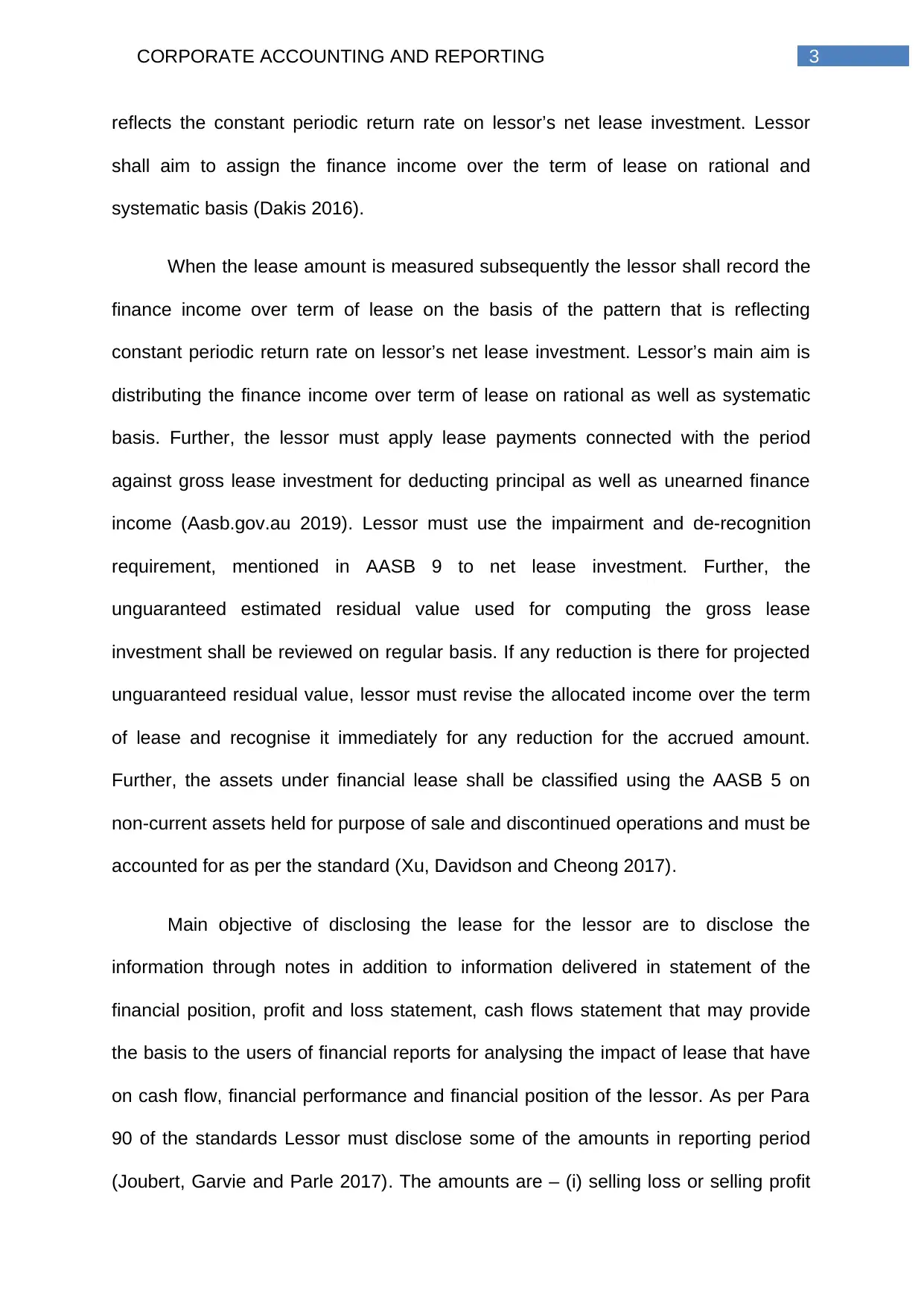
3CORPORATE ACCOUNTING AND REPORTING
reflects the constant periodic return rate on lessor’s net lease investment. Lessor
shall aim to assign the finance income over the term of lease on rational and
systematic basis (Dakis 2016).
When the lease amount is measured subsequently the lessor shall record the
finance income over term of lease on the basis of the pattern that is reflecting
constant periodic return rate on lessor’s net lease investment. Lessor’s main aim is
distributing the finance income over term of lease on rational as well as systematic
basis. Further, the lessor must apply lease payments connected with the period
against gross lease investment for deducting principal as well as unearned finance
income (Aasb.gov.au 2019). Lessor must use the impairment and de-recognition
requirement, mentioned in AASB 9 to net lease investment. Further, the
unguaranteed estimated residual value used for computing the gross lease
investment shall be reviewed on regular basis. If any reduction is there for projected
unguaranteed residual value, lessor must revise the allocated income over the term
of lease and recognise it immediately for any reduction for the accrued amount.
Further, the assets under financial lease shall be classified using the AASB 5 on
non-current assets held for purpose of sale and discontinued operations and must be
accounted for as per the standard (Xu, Davidson and Cheong 2017).
Main objective of disclosing the lease for the lessor are to disclose the
information through notes in addition to information delivered in statement of the
financial position, profit and loss statement, cash flows statement that may provide
the basis to the users of financial reports for analysing the impact of lease that have
on cash flow, financial performance and financial position of the lessor. As per Para
90 of the standards Lessor must disclose some of the amounts in reporting period
(Joubert, Garvie and Parle 2017). The amounts are – (i) selling loss or selling profit
reflects the constant periodic return rate on lessor’s net lease investment. Lessor
shall aim to assign the finance income over the term of lease on rational and
systematic basis (Dakis 2016).
When the lease amount is measured subsequently the lessor shall record the
finance income over term of lease on the basis of the pattern that is reflecting
constant periodic return rate on lessor’s net lease investment. Lessor’s main aim is
distributing the finance income over term of lease on rational as well as systematic
basis. Further, the lessor must apply lease payments connected with the period
against gross lease investment for deducting principal as well as unearned finance
income (Aasb.gov.au 2019). Lessor must use the impairment and de-recognition
requirement, mentioned in AASB 9 to net lease investment. Further, the
unguaranteed estimated residual value used for computing the gross lease
investment shall be reviewed on regular basis. If any reduction is there for projected
unguaranteed residual value, lessor must revise the allocated income over the term
of lease and recognise it immediately for any reduction for the accrued amount.
Further, the assets under financial lease shall be classified using the AASB 5 on
non-current assets held for purpose of sale and discontinued operations and must be
accounted for as per the standard (Xu, Davidson and Cheong 2017).
Main objective of disclosing the lease for the lessor are to disclose the
information through notes in addition to information delivered in statement of the
financial position, profit and loss statement, cash flows statement that may provide
the basis to the users of financial reports for analysing the impact of lease that have
on cash flow, financial performance and financial position of the lessor. As per Para
90 of the standards Lessor must disclose some of the amounts in reporting period
(Joubert, Garvie and Parle 2017). The amounts are – (i) selling loss or selling profit
Paraphrase This Document
Need a fresh take? Get an instant paraphrase of this document with our AI Paraphraser

4CORPORATE ACCOUNTING AND REPORTING
(ii) finance income on net lease investment and (iii) income associated with variable
lease payment that is not included in measurement of net lease investment. Further,
the lessor is required to disclose any additional quantitative as well as qualitative
information with regard to lease activities required for meeting the disclosure
objectives. This additional information may include and not limited to the information
that will assist the users of financial reports for assessing – (i) nature of lessor’s
leasing activities and (ii) how the risk associated by the lessor with rights retains in
the underlying asset. Particularly, the lessor is required to disclose the strategy
applied for risk management associated with the rights retained for the subjected
assets including the means through which lessor reduces the risk (Helalt and
Shogairat 2016).
(ii) finance income on net lease investment and (iii) income associated with variable
lease payment that is not included in measurement of net lease investment. Further,
the lessor is required to disclose any additional quantitative as well as qualitative
information with regard to lease activities required for meeting the disclosure
objectives. This additional information may include and not limited to the information
that will assist the users of financial reports for assessing – (i) nature of lessor’s
leasing activities and (ii) how the risk associated by the lessor with rights retains in
the underlying asset. Particularly, the lessor is required to disclose the strategy
applied for risk management associated with the rights retained for the subjected
assets including the means through which lessor reduces the risk (Helalt and
Shogairat 2016).
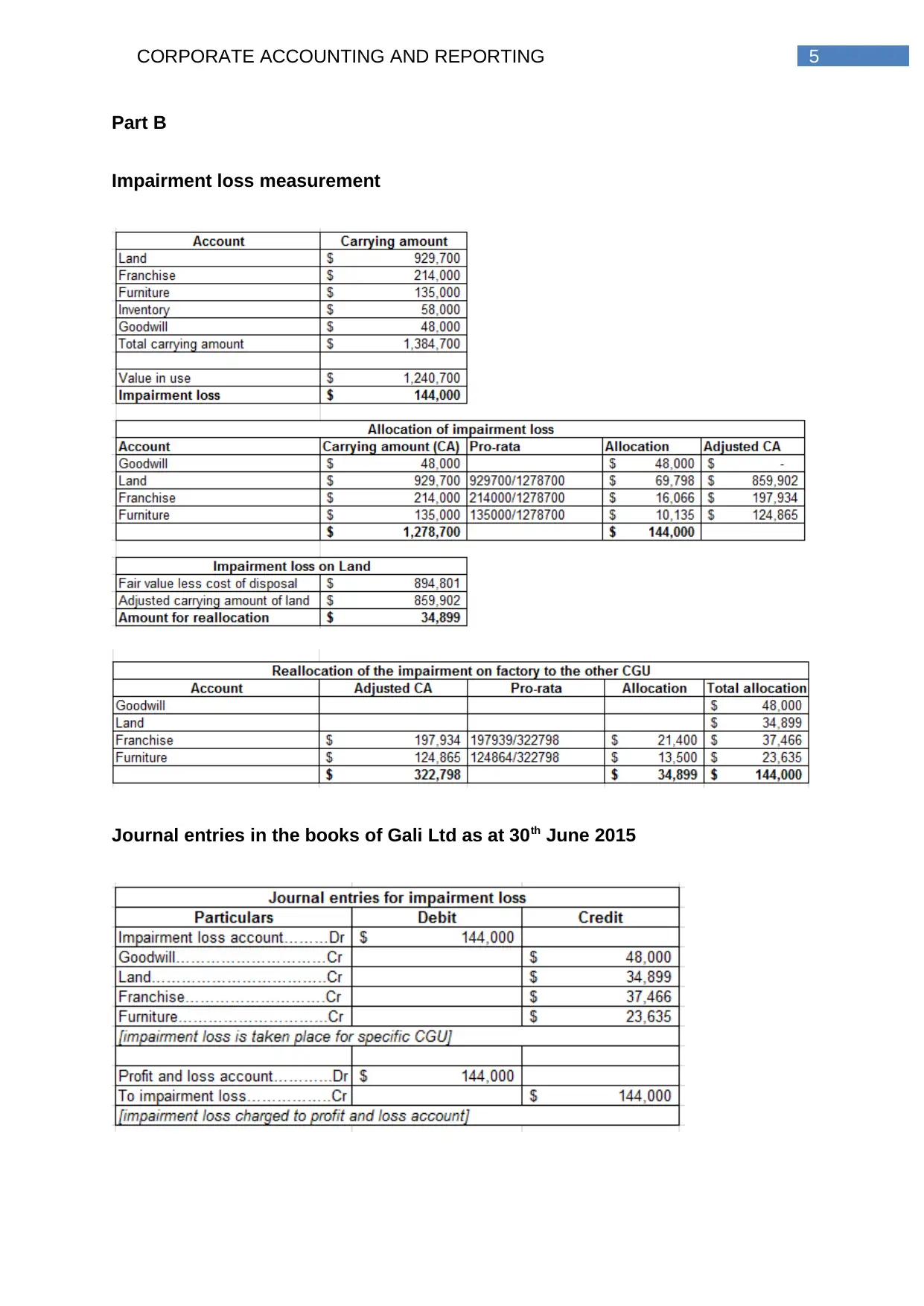
5CORPORATE ACCOUNTING AND REPORTING
Part B
Impairment loss measurement
Journal entries in the books of Gali Ltd as at 30th June 2015
Part B
Impairment loss measurement
Journal entries in the books of Gali Ltd as at 30th June 2015
You're viewing a preview
Unlock full access by subscribing today!
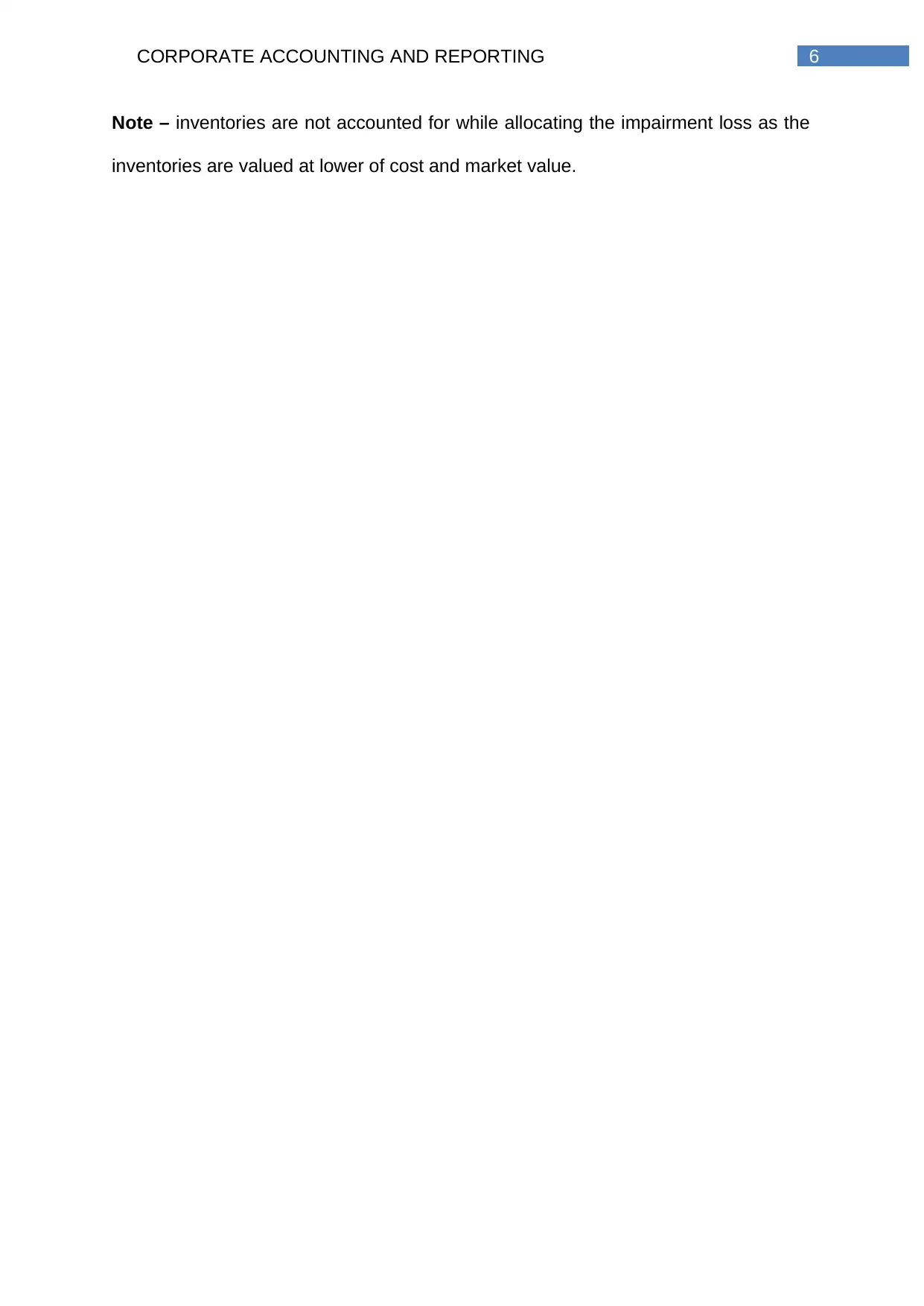
6CORPORATE ACCOUNTING AND REPORTING
Note – inventories are not accounted for while allocating the impairment loss as the
inventories are valued at lower of cost and market value.
Note – inventories are not accounted for while allocating the impairment loss as the
inventories are valued at lower of cost and market value.
Paraphrase This Document
Need a fresh take? Get an instant paraphrase of this document with our AI Paraphraser
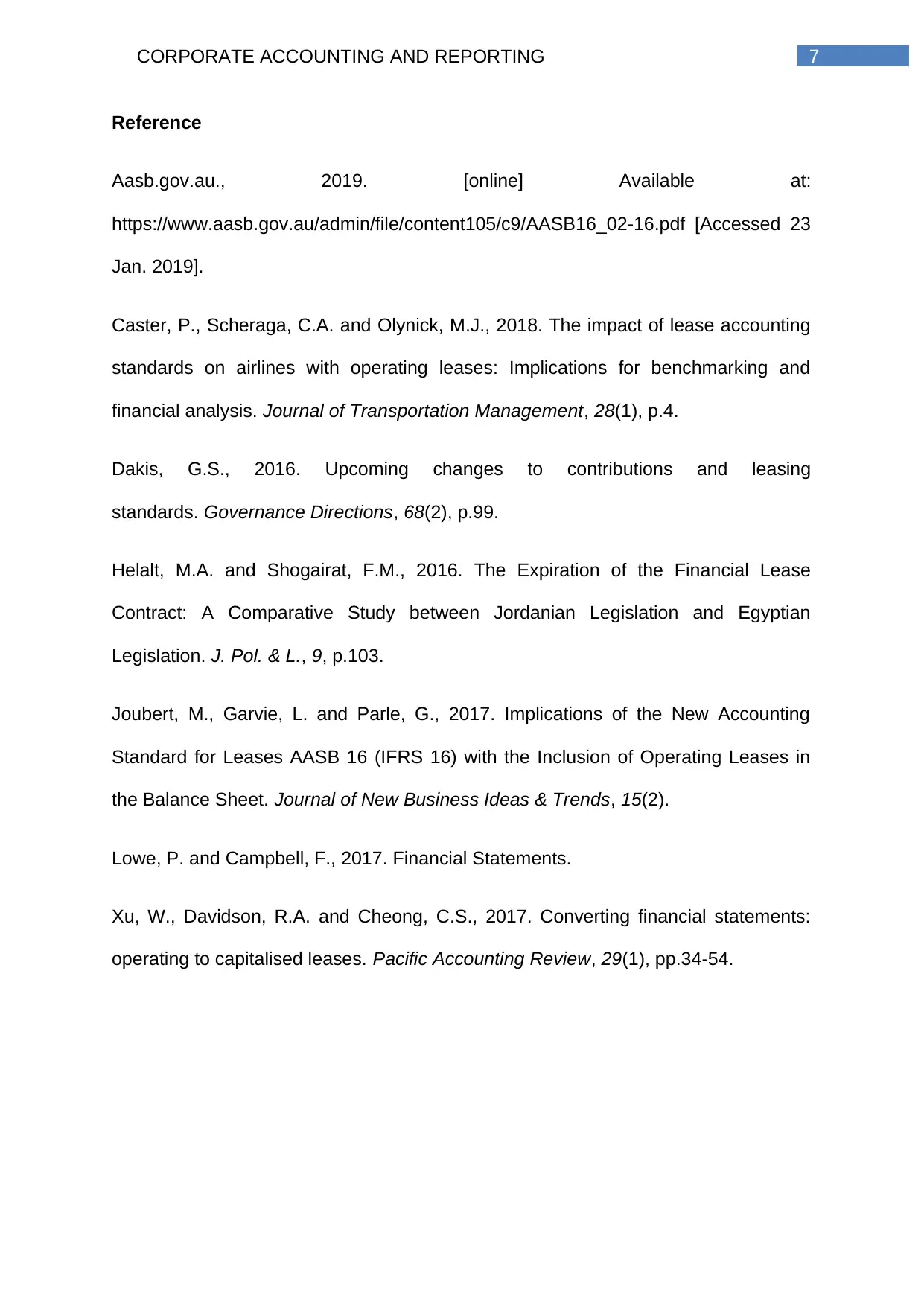
7CORPORATE ACCOUNTING AND REPORTING
Reference
Aasb.gov.au., 2019. [online] Available at:
https://www.aasb.gov.au/admin/file/content105/c9/AASB16_02-16.pdf [Accessed 23
Jan. 2019].
Caster, P., Scheraga, C.A. and Olynick, M.J., 2018. The impact of lease accounting
standards on airlines with operating leases: Implications for benchmarking and
financial analysis. Journal of Transportation Management, 28(1), p.4.
Dakis, G.S., 2016. Upcoming changes to contributions and leasing
standards. Governance Directions, 68(2), p.99.
Helalt, M.A. and Shogairat, F.M., 2016. The Expiration of the Financial Lease
Contract: A Comparative Study between Jordanian Legislation and Egyptian
Legislation. J. Pol. & L., 9, p.103.
Joubert, M., Garvie, L. and Parle, G., 2017. Implications of the New Accounting
Standard for Leases AASB 16 (IFRS 16) with the Inclusion of Operating Leases in
the Balance Sheet. Journal of New Business Ideas & Trends, 15(2).
Lowe, P. and Campbell, F., 2017. Financial Statements.
Xu, W., Davidson, R.A. and Cheong, C.S., 2017. Converting financial statements:
operating to capitalised leases. Pacific Accounting Review, 29(1), pp.34-54.
Reference
Aasb.gov.au., 2019. [online] Available at:
https://www.aasb.gov.au/admin/file/content105/c9/AASB16_02-16.pdf [Accessed 23
Jan. 2019].
Caster, P., Scheraga, C.A. and Olynick, M.J., 2018. The impact of lease accounting
standards on airlines with operating leases: Implications for benchmarking and
financial analysis. Journal of Transportation Management, 28(1), p.4.
Dakis, G.S., 2016. Upcoming changes to contributions and leasing
standards. Governance Directions, 68(2), p.99.
Helalt, M.A. and Shogairat, F.M., 2016. The Expiration of the Financial Lease
Contract: A Comparative Study between Jordanian Legislation and Egyptian
Legislation. J. Pol. & L., 9, p.103.
Joubert, M., Garvie, L. and Parle, G., 2017. Implications of the New Accounting
Standard for Leases AASB 16 (IFRS 16) with the Inclusion of Operating Leases in
the Balance Sheet. Journal of New Business Ideas & Trends, 15(2).
Lowe, P. and Campbell, F., 2017. Financial Statements.
Xu, W., Davidson, R.A. and Cheong, C.S., 2017. Converting financial statements:
operating to capitalised leases. Pacific Accounting Review, 29(1), pp.34-54.
1 out of 8
Related Documents
Your All-in-One AI-Powered Toolkit for Academic Success.
+13062052269
info@desklib.com
Available 24*7 on WhatsApp / Email
![[object Object]](/_next/static/media/star-bottom.7253800d.svg)
Unlock your academic potential
© 2024 | Zucol Services PVT LTD | All rights reserved.




